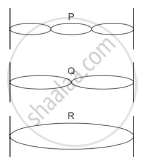Advertisements
Advertisements
प्रश्न
On keeping the stem of a vibrating tuning fork on the surface of a table, a loud sound is heard. Give reason.
उत्तर
When the vibrating tuning fork's stern is pressed against a table's surface, the forceful vibrations create a loud sound on the surface.
APPEARS IN
संबंधित प्रश्न
The adjacent diagram shows three different modes of vibrations P, Q and R of the same string.

(i) Which vibration will produce a louder sound and why?
(ii) The sound of which string will have maximum shrillness?
(iii) State the ratio of wavelengths of P and R.

The diagram above shows a wire stretched over a sonometer. Stems of two vibrating tuning forks A and Bare touched to the wooden box of the sonometer. It is observed that the paper rider (a small piece of paper folded at the centre) present on the wire flies off when the stem of vibrating tuning fork B is touched to the wooden box but the paper just vibrates when the stem of vibrating tuning fork A is touched to the wooden box.
1) Name the phenomenon when the paper rider just vibrates.
2) Name the phenomenon when the paper rider flies off.
3) Why does the paper rider fly off when the stem of tuning fork B is touched to the box?
Give one example to illustrate forced vibrations.
Describe a simple experiment to illustrate the phenomenon of resonance and explain it.
Why are the stringed instruments like guitar provided with a hollow sound box?
Two pendulums C and D are suspended from a wire as shown in the figure give below. Pendulum C is made to oscullate by displaying it from its mean position. It is seen that D also starts oscillating.

(i) Name the type of oscillation, C will execute.
(ii) Name the type of oscillation, D will execute.
(iii) If the length of D is made equal to C then what difference will you notice in the oscillations of D ?
(iv) What is the name of the phenomenon when the length of D is made equal to C ?
What do you understand by free vibrations of a body? Draw a displacement-time graph to represent them. Given one example.
Describe a simple experiment to illustrate the phenomenon of resonance and explain it.
